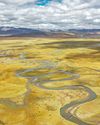
Buddhism emerged in northeastern India between the 6th century and the early 4th century BCE - a time that witnessed a myriad of religions rising, clashing, and spreading.
Buddhism developed from the teachings of the Buddha ("The Awakened One" in Sanskrit), a teacher who lived in northern India. Like many of the sects that developed in northeastern India at the time, Buddhism was constituted by the teachings of the Triratna, the "Three Jewels" of Buddhism - Buddha (the teacher), dharma (the teaching), and sangha (the community). The dates of his birth and death are disputed. Whilst many scholars believe that the Buddha lived from around 563 to 483 BCE, others argue it was nearly 100 years later, from around 448 to 368 BCE.
Northeastern India - which was less influenced by Vedic tradition - became the new ground for Buddhism and its sects. Buddhism then spread from India to China, Korea, and Japan, as well as to Southeast Asia via Sri Lanka. Buddhism played a central role in the spiritual, cultural, and social spheres of Asia, and began to spread to the West from the 20th century onwards.
Two fundamental sects that arose at the time of the Buddha were the Ajivikas and the Jains. Diverging from other Buddhist denominations, both the Ajivikas and the Jains believed in the permanence of the elements that constitute the universe and the existence of the soul.
Over time, two major branches of Buddhism emerged, Mahayana ("Great Vehicle") and Theravada ("School of the Elders"), while a third, Vajrayana ("Diamond Vehicle"), is considered by scholars to be an aspect of Mahayana Buddhism or an entirely separate branch.
هذه القصة مأخوذة من طبعة AG 153 من ASIAN Geographic.
ابدأ النسخة التجريبية المجانية من Magzter GOLD لمدة 7 أيام للوصول إلى آلاف القصص المتميزة المنسقة وأكثر من 9,000 مجلة وصحيفة.
بالفعل مشترك ? تسجيل الدخول
هذه القصة مأخوذة من طبعة AG 153 من ASIAN Geographic.
ابدأ النسخة التجريبية المجانية من Magzter GOLD لمدة 7 أيام للوصول إلى آلاف القصص المتميزة المنسقة وأكثر من 9,000 مجلة وصحيفة.
بالفعل مشترك? تسجيل الدخول

A Spectrum Of Scarlet: The Symbolic Red Of Asian Flags
A common thread that unites many Asian flags is the prominent use of red, a colour rich with symbolism

Curry: A World of Flavour, Tradition, and Culture
From its humble beginnings in India, the concept of "curry" has evolved into a culinary language understood around the world

The Power Of Asian Red Fruits - Discover 10 Nutrient-Rich Gems Of The East
In the vast tapestry of Nature, Asia has gifted the world an array of unique and vibrant fruits, particularly those in shades of red. These scarlet-hued gems, packed with flavour and nutrients, not only add a burst of colour to your plate but also carry valuable health benefits. From antioxidant-rich goji berries to the exotic dragon fruit, let's explore some of the most popular red fruits from Asia and discover why they should be part of your diet.

Bhutan: A World Of Its Own
With its majestic monasteries, red-robed monks, charming rural villages, and vibrant festivals, the Kingdom of Bhutan is a Himalayan paradise that promises an enriching travel experience like no other

Take The Red Pill
From the vermilion torii gates of Japan to the famed rust-hued walls of India's Agra Fort, the burgundy robes of Burmese monks to scarlet chillies drying in the Bangladeshi sun, red is the quintessential colour of Asia.

70 Days for Our Land Animals
Raising awareness about conservation, the environment, and the land-dwelling species of the world

The Red Panda
Meet the elusive guardian of the Eastern Himalayas

Revealed Doctor Yellow
Japan Railways' special lemony Shinkansen is a rare sight to behold

The Mighty Yellow
Over 5,000 kilometres long and flowing through nine provinces and autonomous regions, the Yellow River is China's second largest, after the Yangtze, while its basin is deemed the cradle of Chinese civilisation

Wildlife Big Yellow Beauty
The popular "amelanistic" form of the Burmese python is considered among the most beautiful snakes - if that's your sort of thing